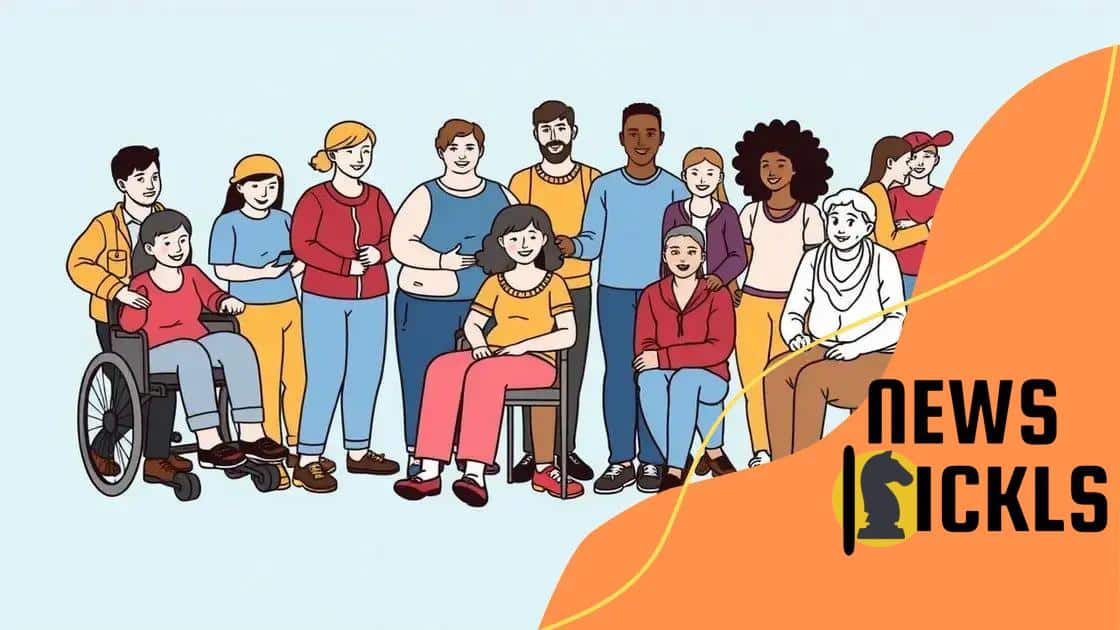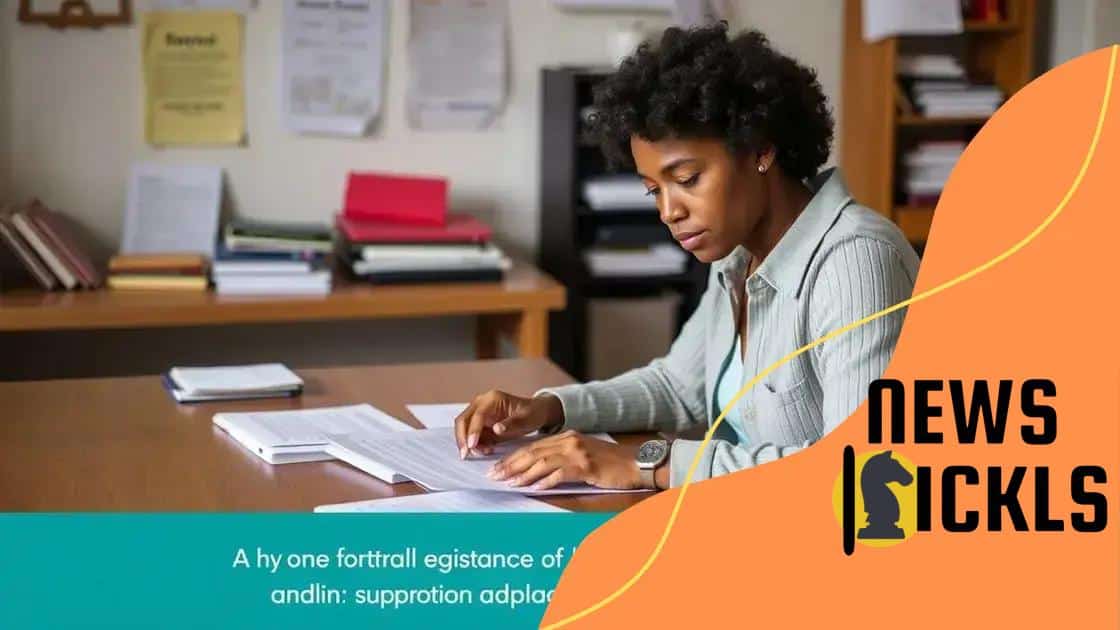Federal assistance for people with disabilities in 2025

Federal assistance for people with disabilities in 2025 encompasses financial aid and various support services, including job training and educational resources, designed to enhance quality of life and promote inclusivity.
Federal assistance for people with disabilities in 2025 is a lifeline for many. As we look towards the future, understanding what’s available can make all the difference in enhancing quality of life.
Current federal programs available in 2025
Understanding the current federal programs available in 2025 is essential for individuals with disabilities. These programs provide vital support and resources to enhance quality of life.
Programs Overview
In 2025, several key federal programs offer assistance to people with disabilities. Each of these programs targets specific needs to ensure comprehensive support.
Major Federal Assistance Programs
- Supplemental Security Income (SSI): Provides financial assistance to disabled individuals with limited income.
- Social Security Disability Insurance (SSDI): Offers benefits to those who have worked and paid Social Security taxes.
- Medicaid: Ensures access to healthcare services for low-income individuals, including those with disabilities.
- Vocational Rehabilitation: Helps individuals with disabilities gain skills and secure employment.
Moreover, programs often include resources such as job training, advocacy services, and educational support. It’s important for individuals to explore these options.
As we assess the benefits listed, it becomes clear that navigating the various levels of assistance can lead to a more fulfilled life. People can engage with authorities to learn more and get guidance on which program aligns best with their needs.
Every person’s journey is unique, and understanding these federal programs can empower individuals to advocate for themselves effectively. Ensuring access to resources helps build a community that supports everyone.
Eligibility requirements for assistance
Knowing the eligibility requirements for assistance is crucial for individuals seeking federal support. Understanding these criteria helps streamline the application process and ensures that you receive the right resources.
General Eligibility Criteria
To qualify for federal assistance programs, individuals typically need to meet basic requirements. These requirements may include income limits, disability status, and residency considerations. Each program may have slightly different criteria.
Specific Requirements
- Income Limits: Most assistance programs have set income thresholds based on household size.
- Disability Verification: Medical documentation is often required to verify the nature and extent of a disability.
- Citizenship Status: Generally, applicants must be U.S. citizens or legal residents.
- Age Restrictions: Some programs may have age limits, such as those specifically for children or seniors.
Additionally, applicants may need to provide proof of previous employment or education, depending on the type of assistance sought. It’s important to gather all necessary documents before applying.
Many people may feel overwhelmed by the process, but knowing what to expect can alleviate anxiety. Programs are designed to support individuals, making the path to assistance more accessible.
As we delve deeper into these eligibility requirements, it becomes apparent that each situation is unique. Tailoring your approach based on the specific program can enhance your chances of receiving the support you need.
How to apply for federal assistance

Applying for federal assistance can seem daunting, but understanding the process simplifies it greatly. There are specific steps you can follow to ensure your application is successful.
Preparation Steps
Before you apply, gather all necessary documents. This may include proof of income, medical records, and identification. Having these items ready can help avoid delays.
Steps to Apply
- Research Programs: Learn about the different federal assistance programs available and find one that suits your needs.
- Complete the Application: Fill out the application form accurately, providing all required information.
- Submit Supporting Documents: Include necessary documentation that supports your application.
- Follow Up: After submitting, keep track of your application status and respond promptly to any requests.
As you complete your application, it is important to pay close attention to details. Small mistakes can lead to delays or denials. If you feel unsure, consider seeking help from local advocacy groups or assistance hotlines to guide you through the process.
Sometimes, applications require additional information or may need to go through several reviews. Keeping communication open with the agency helps ensure you remain informed about your application’s progress.
Persistance is vital during this process. While it might take time, many individuals successfully navigate the assistance application process and secure the support they need to improve their quality of life.
Support services beyond financial aid
When considering support services beyond financial aid, it is important to recognize that assistance comes in many forms. These services can significantly enhance the lives of individuals with disabilities.
Types of Support Services
Federal programs often provide various non-financial assistance, focusing on improving quality of life. These can include educational resources, job training, and counseling.
Educational Resources
- Access to Specialized Training: Many programs offer access to training tailored for people with disabilities, helping them gain necessary skills.
- School Support Services: These resources can help children with disabilities receive appropriate educational accommodations.
- Assistive Technology: Equipment and software that aid in learning and daily tasks are often provided.
Additionally, it’s essential to explore how vocational rehabilitation services can help individuals prepare for and find suitable employment. These services are designed to match skills with job opportunities, leading to fulfilling careers.
Furthermore, counseling and mental health services play a crucial role in overall well-being. Accessing these services can help individuals cope with challenges and build resilience.
By leveraging a combination of financial support and these additional services, individuals with disabilities can build a stable and enriching life. It is beneficial to reach out to local organizations to discover the full range of services available.
Future trends in federal assistance programs
Looking at the future trends in federal assistance programs reveals how these programs are evolving to better meet the needs of people with disabilities. As society changes, these programs adapt to enhance support and accessibility.
Technological Advancements
One significant trend is the integration of technology into assistance programs. This includes the use of online platforms to streamline applications and provide information more efficiently. Increased accessibility through apps and websites improves the user experience and allows for real-time updates.
Focus on Inclusivity
- Holistic Approaches: Future programs may take a more holistic approach, considering not just financial assistance but also mental health and community integration.
- Personalized Assistance: Customizing support based on individual needs can lead to better outcomes for people with disabilities.
- Collaboration with Local Organizations: Partnerships between federal programs and local organizations can enhance resource availability and support.
Furthermore, the increasing recognition of diverse disabilities drives changes in policy and funding. Programs are likely to see expanded definitions of disability to include a wider array of conditions, leading to enhanced eligibility for assistance.
As we look ahead, advocacy is also expected to grow, encouraging policies that reflect the voices of the disability community. Involving those directly affected in the planning and implementation of these programs fosters more effective solutions.
Overall, these trends indicate a future where federal assistance programs are more responsive, inclusive, and user-friendly, ensuring individuals with disabilities receive the comprehensive support they deserve.
In summary, understanding federal assistance for people with disabilities in 2025 involves knowing what resources are available and how to access them. Current programs provide not only financial aid but also vital support services such as education and job training. As we look to the future, trends show that these programs are becoming more inclusive and technologically advanced. By staying informed and proactive, individuals can make the most of the assistance available to them.
FAQ – Frequently Asked Questions about Federal Assistance for People with Disabilities
What types of federal assistance programs are available?
There are various programs, including financial aid, vocational rehabilitation, educational resources, and supportive services that help individuals with disabilities.
How can I apply for federal assistance?
To apply, gather necessary documents, research programs, complete applications accurately, and follow up on your submission.
What support services can I access beyond financial aid?
Support services can include job training, counseling, educational resources, and assistive technology to enhance overall well-being.
What are the future trends in federal assistance programs?
Future trends include the integration of technology for better access, a focus on inclusivity, and the personalization of services to meet individual needs.






